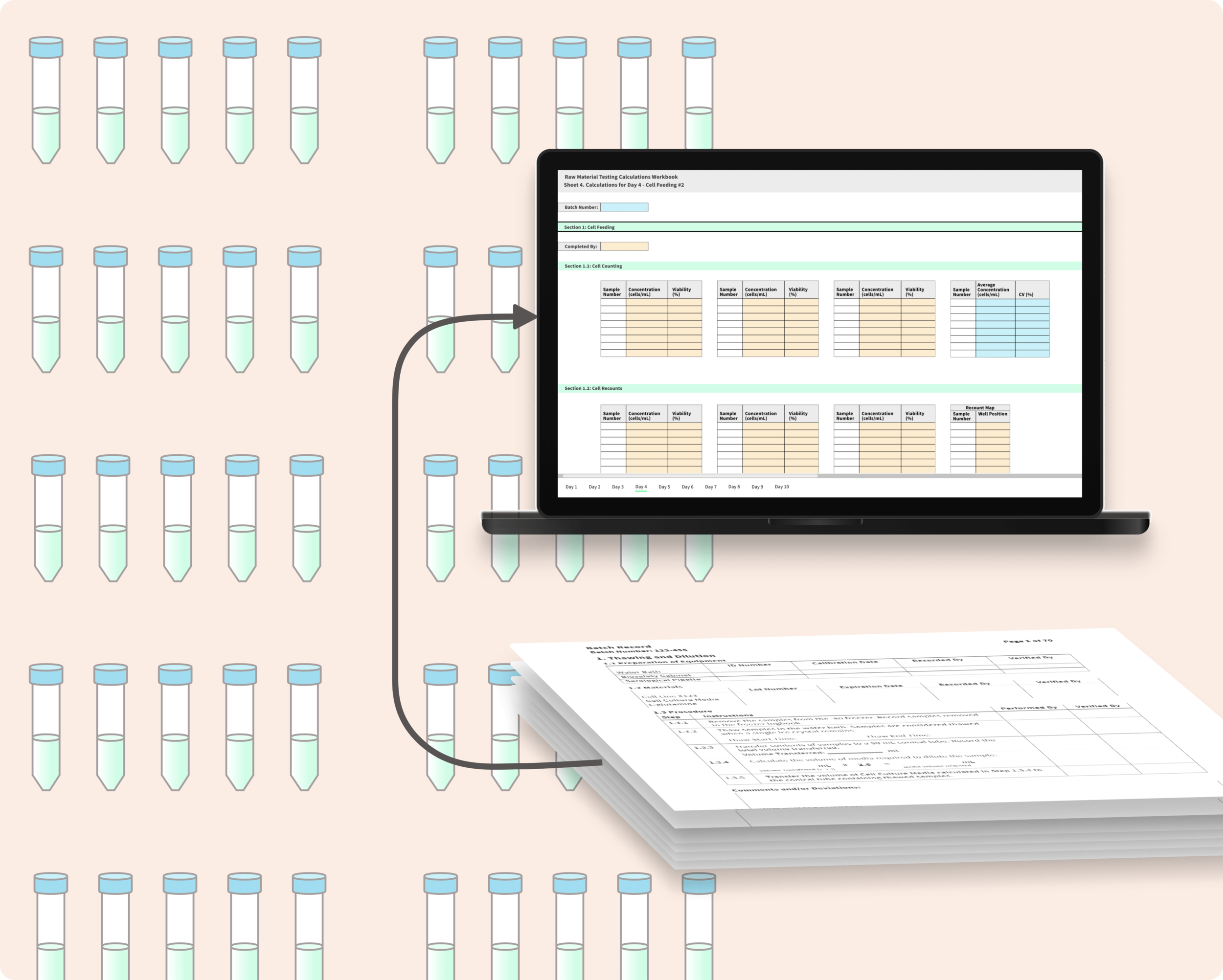Batch Record Overhaul
Design of a GMP-compliant documentation process & data capture template for biopharma laboratory material testing
Note: Images and details in this case study are illustrative of the design process and final product but have been slightly altered in order to protect Bristol Myers Squibb confidential information.
When making drugs for patients, safety is a top priority
The cell therapy division at Bristol Myers Squibb (BMS) confirms the safety of its “raw materials,” the key ingredients in each drug, by first using them in a miniature version of the cell therapy manufacturing process.
By comparing the safety and efficacy of drugs created in the miniature process, BMS can determine if it’s safe to use the new batch for real patients.
Just like baking a cake, manufacturing a drug requires you to follow steps in the right order and add exactly the right amounts of the right ingredients.
In July 2019, the cell therapy team conducted an internal audit to simulate an inspection by the health authorities. The audit uncovered a number of areas where our practices failed to meet good manufacturing practices (GMP).
As a member of the operational improvements team, I was asked to help the raw material testing team redesign their documentation process to meet GMP standards.
- User research
- Process design
- Interaction design
- Pen + paper
- Microsoft Office

The existing documentation process wouldn’t pass muster
For every batch of raw materials tested, the testing team follows a document known as a “batch record” to ensure that every step is performed and that all required information is recorded.
When manufacturing drugs, a good batch record template always contains several elements to ensure that good manufacturing practices are followed.
Previously, the testing team had used an electronic spreadsheet as their batch record template, but per the internal audit, it had two major issues:
It didn’t ask the users to track who had done what.
Even if it did, there was no way to know whether signatures or any other data had been changed.
To meet the GMP guidelines established by the health authorities, I was asked to convert the electronic batch record template into a printable, paper document.
How was the batch record being used?
I studied the existing template and shadowed the operators in the lab for each step of the multi-day testing process. The most glaring thing I noticed was this:
Every time the team tested a raw material batch, they produced close to 50 drug products.
This meant they were performing the scaled-down manufacturing process 50 times in parallel and generating 50x the data and calculating 50x the calculations!
I realized a 100% paper batch record would be impossible.
The testing process produces over 50 miniature drug products, which means that along the way 50x the data are generated and 50x the calculations are required. No wonder the team had been using a spreadsheet!
Balancing data integrity & usability
If the operators had to record all the data and perform all the calculations by hand, the risk of data errors would skyrocket. Instead, I proposed a two-part batch record to the testing team and quality assurance stakeholders:
The proposed hybrid solution would leverage the advantages of both the existing data capture spreadsheet and the requested paper batch record.
Everyone was onboard with this approach as long as the new spreadsheet was simple enough to be validated to confirm that its calculations behaved consistently every time they were used.
Building the new & improved batch record
Simplifying operator signatures
I transferred all existing instructions to the new paper document and added a column for operators to sign and date.
To reduce manual work for the operator, I identified steps that were always performed consecutively and combined their signature fields.
Navigating the spreadsheet
I defined the structure of the workbook to make it as easy to navigate as possible, with one sheet per process day and separate “sections” for each discrete step requiring data entry or calculations.
I added wide section headers to also make it easier for someone scrolling through to find their place.
Streamlining data entry
I had previously noticed that when measuring size and number of cells, the operators didn’t measure samples in numerical order but instead in a custom order.
I organized the tables to match, enabling the operators to directly copy/paste from the equipment’s raw data tables into the spreadsheet.

Iterating on user feedback
When the testing team pressure tested the draft batch record in the lab, they quickly hit a snag: certain activities required two operators.
How do two people simultaneously record what they’re doing in different places on a physical document?
To solve this problem, I “generified” those sections, creating separate sections for Operator 1 and Operator 2 with blank spaces to indicate the samples they’d processed. The two operators could take their designated sheets from the binder and return them once they’d finished.
The new batch record is now part of BMS’s commercial drug process
The new batch record has enabled the team to demonstrate the characteristics that health authorities expect to ensure data integrity. The new documentation package allowed us to cross this gap off our checklist and it’s now in place for BMS’s commercial drug product process.
The finalized batch record document template, locked data capture spreadsheet template, and batch record management protocol (not discussed here) that I designed have worked so well for the raw material testing team that they plan to continue adapting it for their future projects.

“Sophia has helped our team solidify our documentation system by designing a 180+(!!!!!) page paper batch record, and an accompanying validated electronic workbook.
[...] Sophia had to do a lot of out-of-the-box thinking, and the end result absolutely blew me away. I can’t imagine all the time it took to finish the work, and I am incredibly grateful for Sophia’s optimism and perseverance throughout the design process.”
Communicate with stakeholders early
During the workbook design process, I touched base with the validation team several times. However when it came time for validation, it turned out we didn’t have a clear plan or scope, which made validation more difficult than it needed to be.
Going forward, I would invest more time upfront communicating with my collaborators to make sure we have a clear plan and responsibilities.





